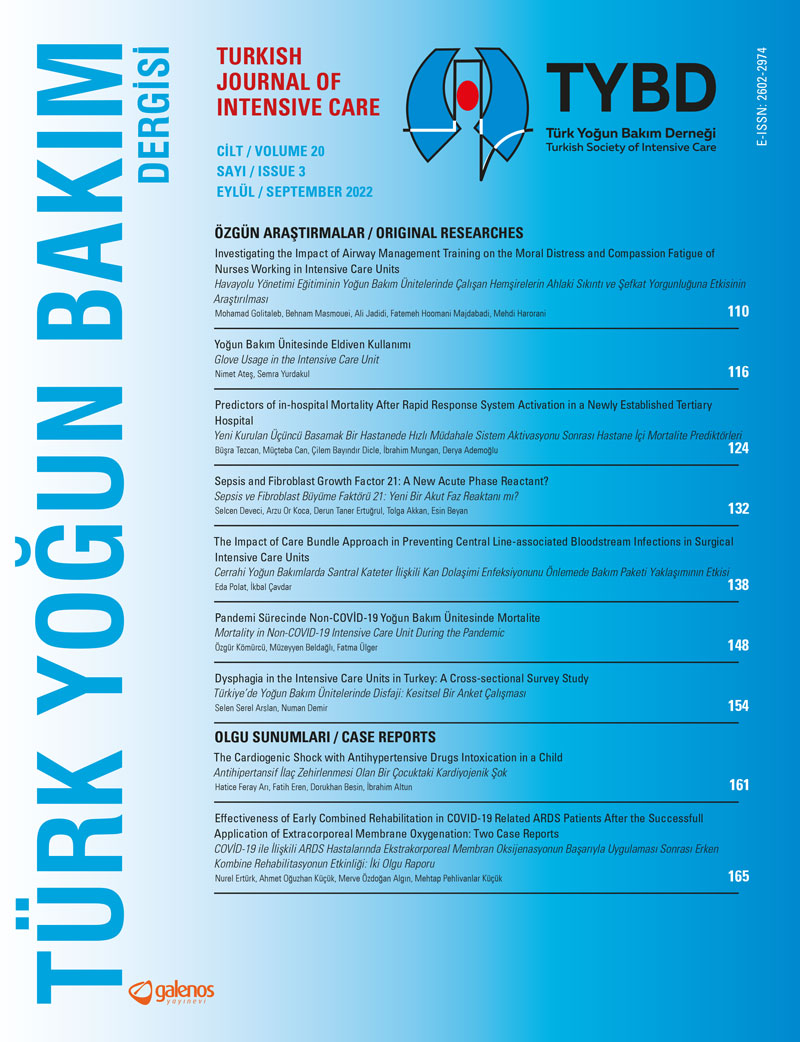Öz
Amaç:
Bu çalışmada akut metabolik dekompanzasyon olan sepsisli ve non-enfeksiyöz enflamatuvar durumlu hastaların fibroblast büyüme faktörü 21 (FGF 21) düzeylerini, enfeksiyon parametreleri ve skorlama sistemleri ile karşılaştırmak amaçlandı.
Gereç ve Yöntem:
Kesitsel olarak dizayn edilen çalışmada olgu grubuna 46 sepsis tanısı olan hasta ile 29 non-enfeksiyöz enflamatuvar durum tanısı olan hasta ve kontrol grubuna da 39 sağlıklı gönüllü dahil edildi. Tüm hastaların C-reaktif protein, prokalsitonin (PCT), sedimentasyon ve FGF 21 düzey ölçümleri yapıldı. Akut fizyoloji ve kronik sağlık değerlendirmesi-II, sequential organ failure assessment skorlamaları hesaplandı.
Bulgular:
Sepsis ve non-enfeksiyöz enflamatuvar durum gruplarındaki FGF 21 düzeyleri, kontrol grubuna göre anlamlı olarak daha yüksek bulundu (p˂0,001). FGF 21 düzeyi ile sadece PCT düzeyi arasında zayıf pozitif bir korelasyon olduğu görüldü (r=0,292 p=0,011). FGF 21 ölçümlerinin 492,4 pg/mL ve üzerinde olmasının %82,4 sensitivite ve %80 spesifisite ile sepsis ve non-enfeksiyöz enflamatuvar durum tanılarını öngörebildiği gösterildi.
Sonuç:
Sonuç olarak, FGF 21, enfeksiyöz tablolarda PCT gibi yükselmesi, ancak her akut tabloda artmaması nedeni ile akut faz reaktanı olarak kabul edilmesinden dolayı şüpheli bir parametre olarak değerlendirilebilir.
Anahtar Kelimeler: Fibroblast büyüme faktörü 21, sepsis, mortalite
Referanslar
- Singer M, Deutschman CS, Seymour CW, Shankar-Hari M, Annane D, Bauer M, et al. The Third International Consensus Definitions for Sepsis and Septic Shock (Sepsis-3). JAMA 2016;315:801-10.
- Hotchkiss RS, Karl IE. The pathophysiology and treatment of sepsis. N Engl J Med 2003;348:138-50.
- Genga KR, Russell JA. Update of Sepsis in the Intensive Care Unit. J Innate Immun 2017;9:441-55.
- Li X, Zhu Z, Zhou T, Cao X, Lu T, He J, et al. Predictive value of combined serum FGF21 and free T3 for survival in septic patients. Clin Chim Acta 2019;494:31-7.
- van Engelen TSR, Wiersinga WJ, Scicluna BP, van der Poll T. Biomarkers in Sepsis. Crit Care Clin 2018;34:139-52.
- Marik PE. Procalcitonin is an essential biomarker for hydrocortisone, ascorbic acid, and thiamine (HAT) therapy in patients with sepsis. Crit Care 2019;23:151.
- Suárez-Santamaría M, Santolaria F, Pérez-Ramírez A, Alemán-Valls MR, Martínez-Riera A, González-Reimers E, et al. Prognostic value of inflammatory markers (notably cytokines and procalcitonin), nutritional assessment, and organ function in patients with sepsis. Eur Cytokine Netw 2010;21:19-26.
- Reinhart K, Bauer M, Riedemann NC, Hartog CS. New approaches to sepsis: molecular diagnostics and biomarkers. Clin Microbiol Rev 2012;25:609-34.
- Tomasiuk R, Mikaszewska-Sokolewicz M, Szlufik S, Rzepecki P, Lazowski T. The prognostic value of concomitant assessment of NT-proCNP, C-reactive protein, procalcitonin and inflammatory cytokines in septic patients. Crit Care 2014;18:440.
- Dias AT, Matta Pde O, Nunes WA. Índices de gravidade em unidade de terapia intensiva adulto: avaliação clínica e trabalho da enfermagem [Severity indexes in an adult intensive care unit: clinical evaluation and nursing work]. Rev Bras Ter Intensiva 2006;18:276-81.
- Luo XP, Wang HH, Hu SF, Wu SJ, Xie GH, Cheng BL, et al. [Comparison of three different organ failure assessment score systems in predicting outcome of severe sepsis]. Zhonghua Wai Ke Za Zhi 2009;47:48-50.
- Trancă S, Petrișor C, Hagău N, Ciuce C. Can APACHE II, SOFA, ISS, and RTS Severity Scores be used to Predict Septic Complications in Multiple Trauma Patients? J Crit Care Med (Targu Mures) 2016;2:124-30.
- Türe M, Memiş D, Kurt I, Pamukçu Z. Predictive value of thyroid hormones on the first day in adult respiratory distress syndrome patients admitted to ICU: comparison with SOFA and APACHE II scores. Ann Saudi Med 2005;25:466-72.
- Goetz R, Beenken A, Ibrahimi OA, Kalinina J, Olsen SK, Eliseenkova AV, et al. Molecular insights into the klotho-dependent, endocrine mode of action of fibroblast growth factor 19 subfamily members. Mol Cell Biol 2007;27:3417-28.
- Itoh N, Ohta H, Konishi M. Endocrine FGFs: Evolution, Physiology, Pathophysiology, and Pharmacotherapy. Front Endocrinol (Lausanne) 2015;6:154.
- BonDurant LD, Ameka M, Naber MC, Markan KR, Idiga SO, Acevedo MR, et al. FGF21 Regulates Metabolism Through Adipose-Dependent and -Independent Mechanisms. Cell Metab 2017;25:935-44.e4.
- Xie T, Leung PS. Fibroblast growth factor 21: a regulator of metabolic disease and health span. Am J Physiol Endocrinol Metab 2017;313:E292-302.
- Suassuna PGA, de Paula RB, Sanders-Pinheiro H, Moe OW, Hu MC. Fibroblast growth factor 21 in chronic kidney disease. J Nephrol 2019;32:365-77.
- Su X, Kong Y, Peng D. Fibroblast growth factor 21 in lipid metabolism and non-alcoholic fatty liver disease. Clin Chim Acta 2019;498:30-7.
- Olszanecka-Glinianowicz M, Madej P, Wdowczyk M, Owczarek A, Chudek J. Circulating FGF21 levels are related to nutritional status and metabolic but not hormonal disturbances in polycystic ovary syndrome. Eur J Endocrinol 2015;172:173-9.
- Gariani K, Drifte G, Dunn-Siegrist I, Pugin J, Jornayvaz FR. Increased FGF21 plasma levels in humans with sepsis and SIRS. Endocr Connect 2013;2:146-53.
- Feingold KR, Grunfeld C, Heuer JG, Gupta A, Cramer M, Zhang T, et al. FGF21 is increased by inflammatory stimuli and protects leptin-deficient ob/ob mice from the toxicity of sepsis. Endocrinology 2012;153:2689-700.
- Li X, Zhu Z, Zhou T, Cao X, Lu T, Liang Y, et al. Early increases in serum FGF21 levels predict mortality of septic patients. Cytokine 2018;111:428-33.
- American College of Chest Physicians/Society of Critical Care Medicine Consensus Conference: definitions for sepsis and organ failure and guidelines for the use of innovative therapies in sepsis. Crit Care Med 1992;20:864-74.
- Nasimfar A, Sadeghi E, Karamyyar M, Manesh LJ. Comparison of serum procalcitonin level with erythrocytes sedimentation rate, C-reactive protein, white blood cell count, and blood culture in the diagnosis of bacterial infections in patients hospitalized in Motahhari hospital of Urmia (2016). J Adv Pharm Technol Res 2018;9:147-52.
- Wang S, Chen D. [The correlation between procalcitonin, C-reactive protein and severity scores in patients with sepsis and their value in assessment of prognosis]. Zhonghua Wei Zhong Bing Ji Jiu Yi Xue 2015;27:97-101.
- Camporez JP, Jornayvaz FR, Petersen MC, Pesta D, Guigni BA, Serr J, et al. Cellular mechanisms by which FGF21 improves insulin sensitivity in male mice. Endocrinology 2013;154:3099-109.
- Véniant MM, Komorowski R, Chen P, Stanislaus S, Winters K, Hager T, et al. Long-acting FGF21 has enhanced efficacy in diet-induced obese mice and in obese rhesus monkeys. Endocrinology 2012;153:4192-203.
- Yu Y, He J, Li S, Song L, Guo X, Yao W, et al. Fibroblast growth factor 21 (FGF21) inhibits macrophage-mediated inflammation by activating Nrf2 and suppressing the NF-kB signaling pathway. Int Immunopharmacol 2016;38:144-52.
Telif hakkı ve lisans
Telif hakkı © 2022 Yazar(lar). Açık erişimli bu makale, orijinal çalışmaya uygun şekilde atıfta bulunulması koşuluyla, herhangi bir ortamda veya formatta sınırsız kullanım, dağıtım ve çoğaltmaya izin veren Creative Commons Attribution License (CC BY) altında dağıtılmıştır.






















